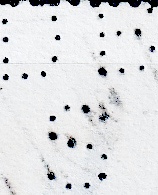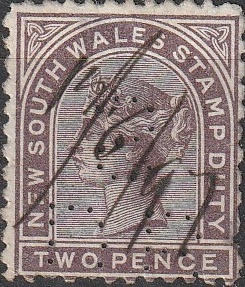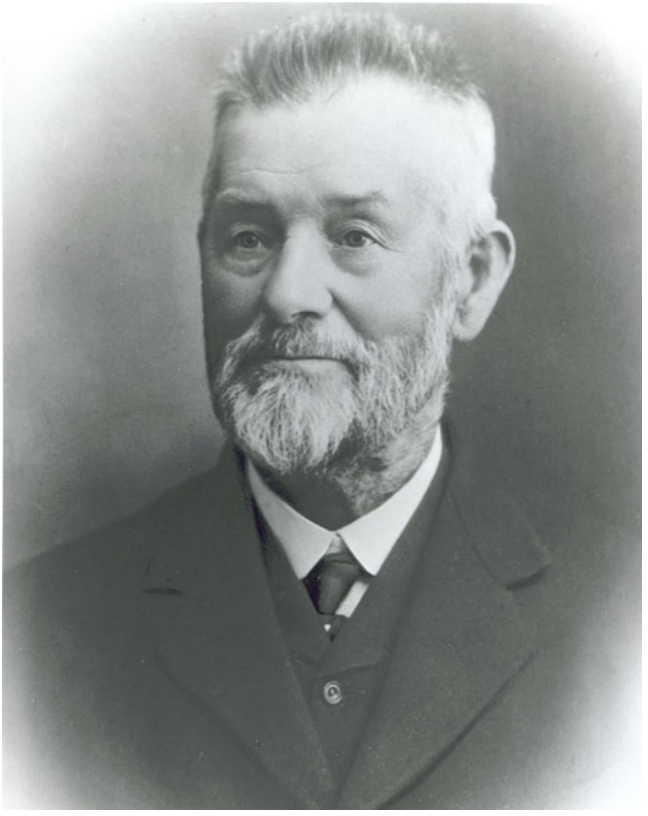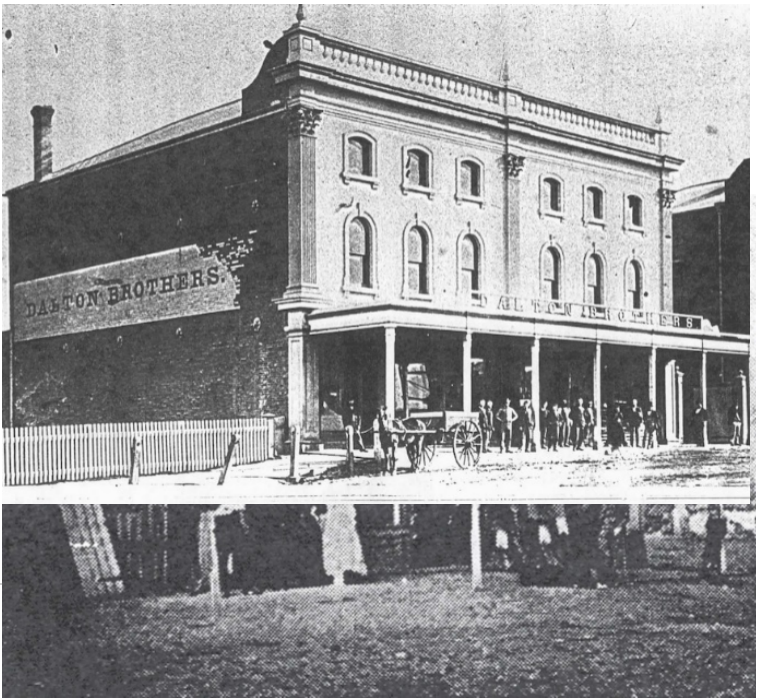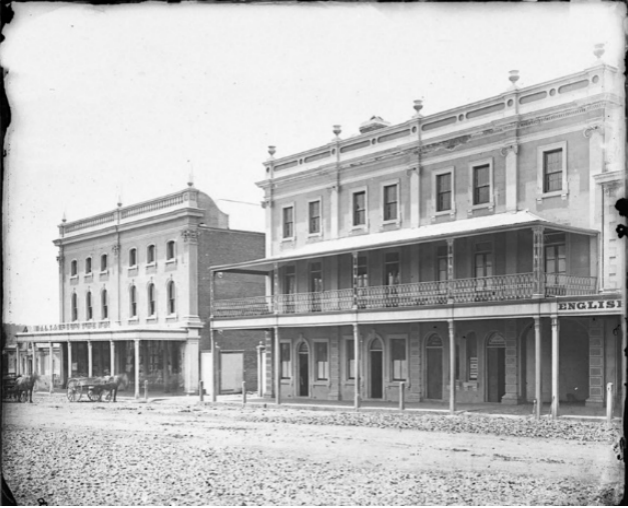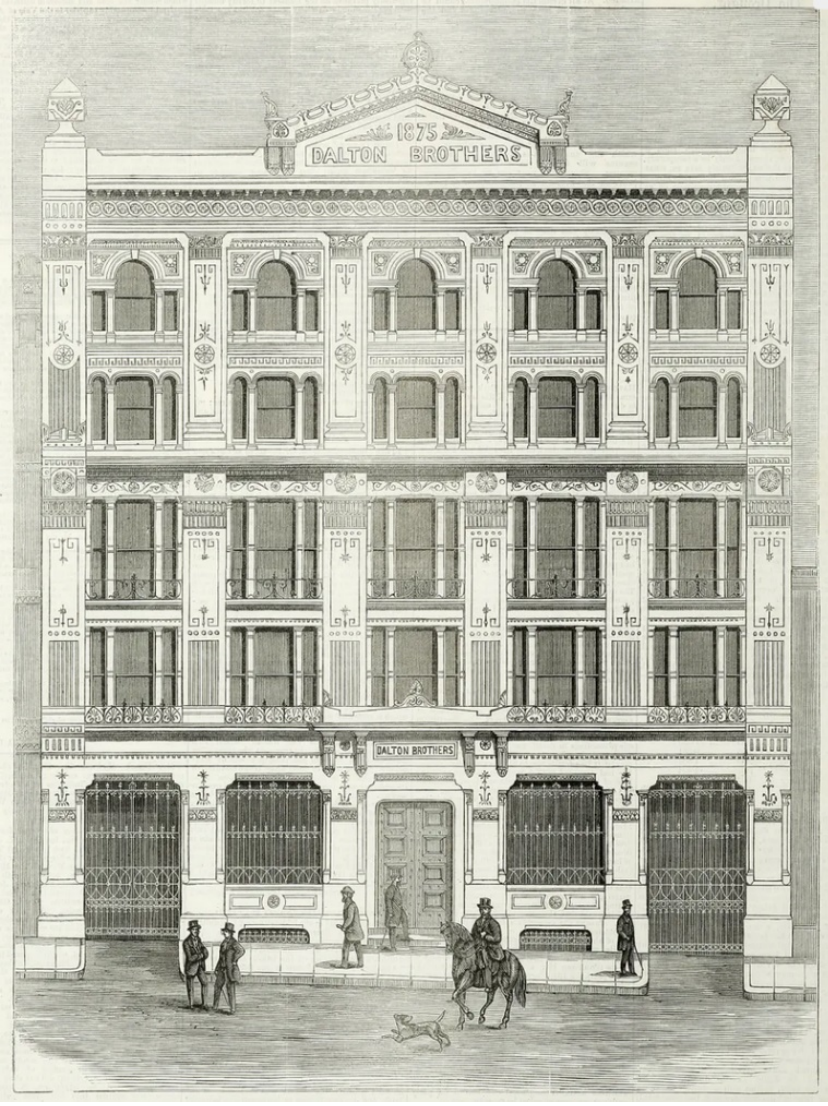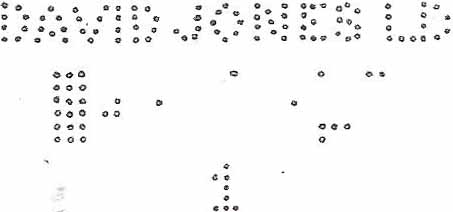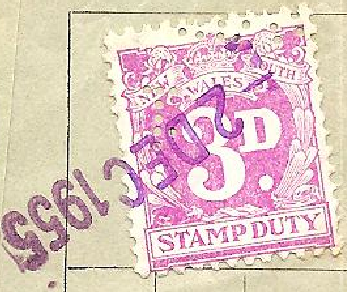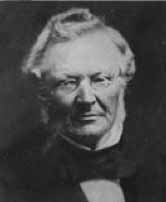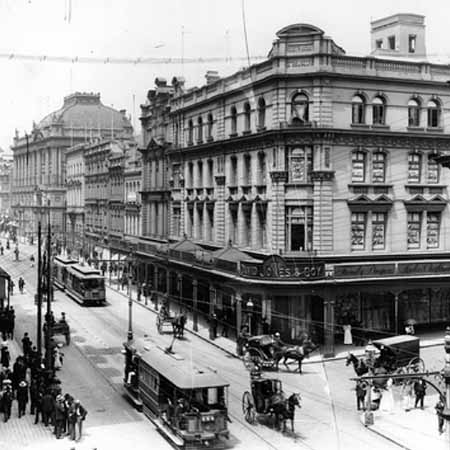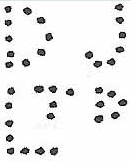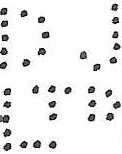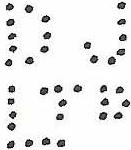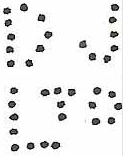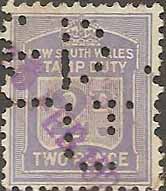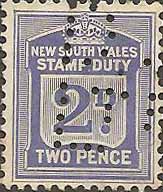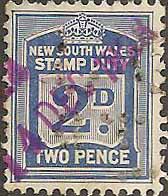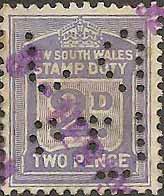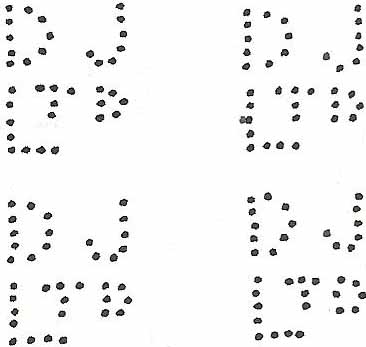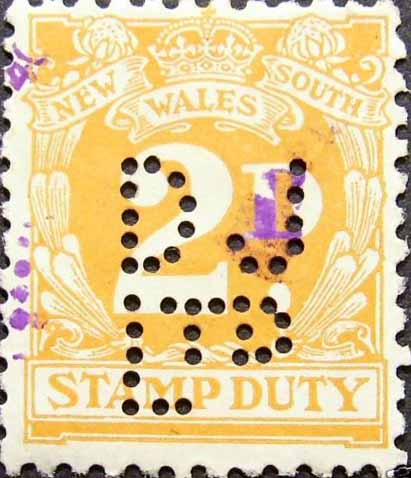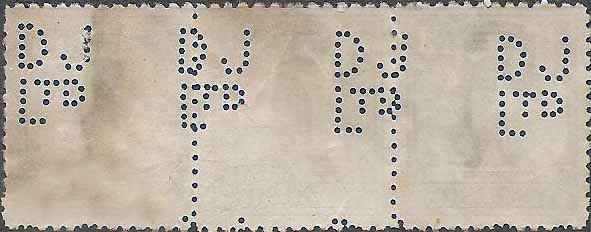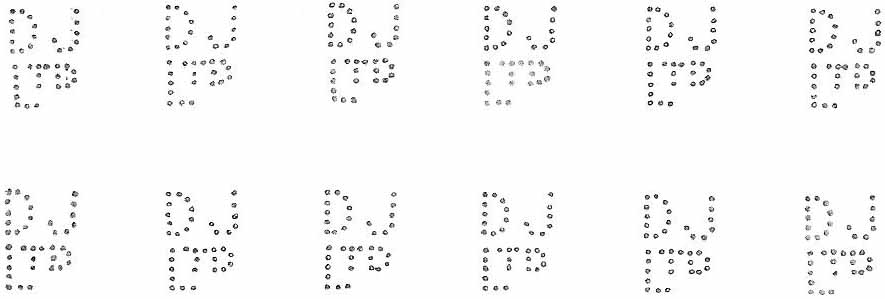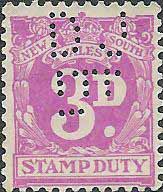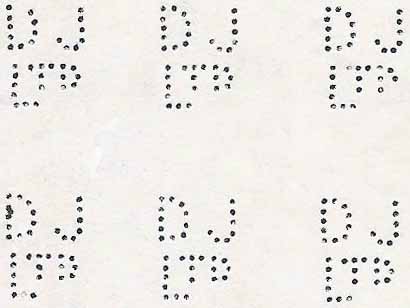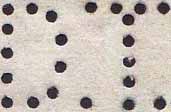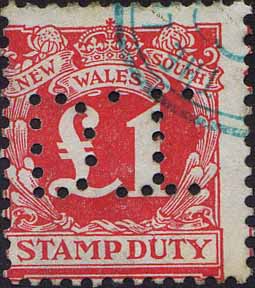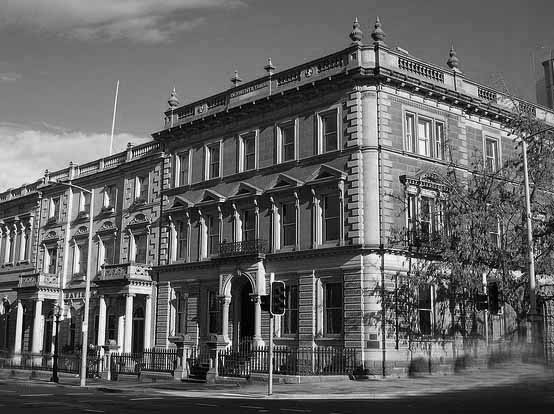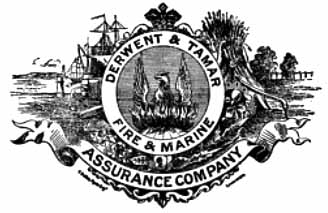|
Private Revenue Perfins of New South Wales An Elsmore Coath production The authors would welcome your comments additions or input into this work A B C D E F G H I J K L M N O P Q R S T U V W Y Other D
-------------------------------------------------------- DB/S.a
User: Dalton Brothers of
Sydney Ltd General Merchants
and Warehouses Address: 115 Pitt St, Sydney, NSW Revenue Use: QV 1881 issue 2d Rarity Scale: QV 1881 issue 2d R4 Background: *James Dalton (1834-1919), merchant and pastoralist, was born in Duntryleague, Limerick, Ireland, son of James Dalton, innkeeper, and his first wife Eleanor, née Ryan. Because of the Great Famine (sometimes called the Irish Potato Famine 1945-49) James (junior) went to New South Wales with his father in the late 1840s.
Some
sources place James (senior) already in NSW as a
result of being transported for his role in a
Kidnapping in Ireland in the 1830’s. He is said to
have secured a Ticket of Leave in 1840 and then
moved to Orange. Around
the early 1850’s James (junior) was joined by his
brother Thomas, and the firm became known as Dalton
Bros.
In
addition, they built stores in lower Fort Street and
a wharf and bond warehouses at Millers Point. At
this time, they continued to expand their pastoral
holdings including the purchase of “Ammerdown” and
“Kangaroobie”.
Device: The DBS.a device was a single die device
that came into use in about 1897 in Sydney. The pins
in the puncturing head were very fine and this seems
to have contributed to it short usage period.
Because of the short period of usage, the pattern is
rare even on postage stamps however revenue use is
even rarer with only a handful of examples known. *Wikipedia, “Town and Country Journal” 1 April 1876, Australian Dictionary of Biography, “Central West Daily” article “Daltons in Orange: Iconic family celebrates legacy” 17 March 2019. ABC News “The Retail Heart of Orange” 24 May 2016. -------------------------------------------------------- DAVID JONES LD.a
User: David Jones Ltd Department Store Address: Elizabeth & Market St's, Sydney, NSW Revenue Use: Numeral 1929-66 issue 3d Rarity Scale: Numeral 1929-66 issue 3d R4 Background: *David Jones, was born on 8 March 1793, the son of Thomas and Nancy Jones, farmers from Llandeilo, Wales. Jones was apprenticed to a grocer and at the age of just 18 was given management of a general store in Eglwyswrw, Pembrokeshire. Jones married in 1813 but his wife Catherine Hughes died in childbirth, Jones remarried in September 1822 to Elizabeth Williams who died in 1826.Jones moved to London, finding work in the retail trade and in 1828 he married Jane Hall. It was through her family and religious (they were Independents, that is Protestant Christians but not aligned to any denomination) connections and those of his employers that he met the visiting businessman Charles Appleton, from Hobart, who had opened a store in Sydney in 1825. Jones resigned his job and entered into partnership with Appleton, which included the Australian branches under the style of Appleton & Co. In October 1834 Jones sailed with his family for Hobart, and spent time in Launceston before arriving in Sydney in September 1835. Appleton had a partner in Sydney named Robert Bourne, but this partnership expired at the end of 1835 and the company became Appleton & Jones. Shortly after this Appleton joined Jones in Sydney but they had some disagreements about credit policies and the partnership was dissolved by mutual consent in 1838. After the split Jones moved to premises on the corner of George Street and Barrack Lane. Jones formed associations with family friends and 'Independents' in London to secure stock and arranged back loads of wool and tallow and other produce from the colonies. Jones business prospered despite the depression of the 1840’s and by 1856 he took on partners and retired from active management. However the firm did not do well and soon after Jones had to buy out his partners and return to managing the business. Borrowing heavily and making new partnerships he was able to turn the business around and pay out the company’s debts. He finally retired in 1868 and died at his home in Lyons Terrace, Liverpool Street, Sydney, on 29 March 1873. His wife died three weeks later, aged 71. As a businessman Jones did not limit himself to retail and he had many interests including investments in banks, steamships, building and insurance, where he was a director of the Mutual Fire Insurance Co. and the Australian Mutual Provident Society. He also had political involvements as a member of the first Sydney City Council (1842) and of the New South Wales Legislative Council in 1856-60. Jones had four sons and four daughters by his third marriage. The eldest son David and his brother George became pastoralists, his second son, Philip (later Sir) became a physician and the youngest son, Edward succeeded his father in the business.
David Jones c1860
George St premises
Edward Jones had traveled widely overseas, and from these experiences he redirected the company more in the fashion of the European ‘Department’ Stores. Edward oversaw the rebuilding of the George Street store in 1887 and the building boasted Sydney’s first hydraulic lift and the store included a broader range of goods, including furniture and furnishings. In 1890 the company released its first catalogue and established a mail order department, a step that would lead to the purchasing of large amounts of postage stamps and in turn the need for perforating devices.
The company invested significantly in local design and manufacture establishing a factory in Marlborough Street, which manufactured a huge variety of goods from clothing to luggage.
In 1906, David Jones became a public company and in 1920 it was listed on the stock exchange. In the early 1920’s, David Jones Limited, now with Charles Jones (Junior) as chairman, undertook the building of the new Elizabeth St. store located on a site on Market St. between Elizabeth St. and Castlereagh St. This store opened in 1927 and remains David Jones Limited's 'flag ship' store to this day. Later in 1938 the company opened another store on Market St.
After the end of World War 2 the company expanded to eight stores by 1959, and in the next 20 years would expand to Queensland, Australian Capital Territory, Victoria and South Australia, creating a national retail chain which in 2012 numbered 36 stores. In 1982, the company acquired the Melbourne department store, Buckley & Nunn, including its properties in Bourke St, and the first David Jones store in Melbourne opened that same year. In 1985, the company acquired Adelaide department store John Martins, and later established a presence in Western Australia.
Device: David Jones Limited of Sydney were long term perfin users with devices for use with postage and revenue stamps as well as other canceling devices for use with incoming correspondence, mail orders and the like.
The company used the following on revenue and postage stamps:
DJLTD.a, b, c & d 1920-1941. 4 head device (2 wide x 2 high)
DJLTD.e 1908-1951. 12 head device (6 wide x 2 high)
DJLTD.f 1949-1975. 6 head device (3 wide x 2 high)
In addition David Jones used the following cancelling devices (see NSW Other section Cancelling Devices):
PAID D.JONES&CO.a 1890-1892
In addition there is this rather large DAVIDJONESLD.a device, which, although having the appearance of being a cancelling device, is not reported used in this manor. This is not unusual as the initial role of the device was possibly to date incoming correspondence and orders and therefore examples of this strike would only exist in company records.
Oddly it is reported used as a perforating device from as early as 1950 until at least 1958.
Earlier usage on postage stamps has been reported from 1948 but the evidence we have seen does not support this. Postmark evidence is hard to obtain as the usage on postage stamps perforated with this DAVIDJONESLD.a pattern tend to be parcel cancellations.
Until recently the pattern was not known on revenue stamps and the example we have shown is the first one that we have seen. You will note that it is on piece and the document is not punctured, indicating that the revenue stamp was punctured prior to being affixed to the document, thus confirming the usage as a true perfin rather than a strike from a cancelling device.
Given the size of the pattern it will always appear as a partial strike. The banks of pins under the DAVIDJONESLD were most likely meant to be for a number sequence for a date but we have not sighted any with dates. In fact all examples we have sighted on postage and revenue stamps show these banks as random pins and they are never structured as numbers. Evidence from multiples carrying one or more strikes of this pattern show no consistent relationship between strikes which is evidence that it was a single die device, which is consistent with its use as a cancelling device.
The pins under the words DAVIDJONESLD are most likely in a series of blocks of 6 pins high and 3 pins wide. The gap between the blocks of pins seems to be slightly different to the gap between the pins within the block and as a result it is very hard to accurately predict the exact layout of the blocks, but we would estimate that there were 6 blocks. This would permit a day/month/year format and this is consistent with the earlier PAID D.JONES&CO device.
The presence of these blocks of pins under the DAVIDJONESLD means that the full pattern was not only wide but also quite tall. Multiple strikes often appear as over strikes and can be quite confusing. It seems that when the device was being used as a perforating device the operator was trying to get the key words 'David Jones Ld' to be on each row of stamps.
In addition the number ‘1’ that appears in the pattern is found in a variety of positions in relationship to words David Jones Ld. Sometimes mixed in with the letters of the main pattern and other times on an angle to the pattern. Again this is because of the height of the pattern and apparent desire to get the name David Jones clearly onto each row of stamps means that strikes are frequently over the top of each other. The only consistent location for the number is at the base of the pattern under the 6 banks of number pins. Only the number '1' is reported and it raises the possibility that the device in its original function as a cancelling device may have been one of a number of similar devices.
Despite the fact that the pattern is found used over an extended period, between the early 1950’s and the end of 1957, it is still a scarce pattern, even on postage stamps. This combined with the fact that different strikes show different structure in the number blocks suggests that the device was still in use as a cancelling device when it was employed as a perforating device. It is possible that the device was sometimes used as stopgap perforator when the DJLTD.1 and 2 devices were not operating. Related patterns: Refer to other David Jones Limited patterns in: NSW: DJ/LTD.a DJ/LTD.b DJ/LTD.c DJ/LTD.d DJ/LTD.e DJ/LTD.f Other – Section 1 Commercial Perfins and Cancelling Devices: (PAID) DJONES&CO.a Other - Section 2 Commercial Overprints: DAVID/JONES/LTD.a DAVID JONES/LTD.b DAVID JONES/LTD.c DAVID JONES/LTD.d DAVID JONES/LTD.e DAVID JONES/LTD.f DAVID JONES/LTD.g QLD: Other - Section 2 Commercial Overprints: DAVID/JONES.a WA: Other - Section 2 Commercial Overprints: DAVID JONES/(PERTH)/LTD..a *David Jones website
Wikipedia
Australia Dictionary of Biography -------------------------------------------------------- DJ/LTD.a .b .c .d
.a .b .c .d
User: David Jones Ltd Department Store Address: Elizabeth & Market St's, Sydney, NSW Revenue Use: Numeral 1917 wmk NSW Rarity Scale: Numeral 1917 wmk NSW R3 Background: See DAVIDJONESLD.a above Device: The DJLTD.a, b, c & d device is a four-die device in a 2 x 2 format. The dies are easily discernable so we have listed it as four patterns.
The device was in use between 1920 until at least 1941. From the structure of the device and the timing of its introduction, it would seem most likely that it was intended to produce strikes in position 2 (or similar) on the contemporary postage stamps of the period, the kangaroo and KGV issues. However the dies are quite large and when applied to smaller format stamps such as the 1917 type Numeral revenue stamps of NSW and the KGVI definitive postage stamps of Australia it almost always appears as a partial.
The existence of these patterns on NSW revenue stamps was unreported until 1995 and then it was only reported to have been found on DJ/LTD.d. This seems odd given the known structure of the device.
Related patterns: Refer to other David Jones Limited patterns in: NSW: DAVIDJONESLD.a DJ/LTD.e DJ/LTD.f Other – Section 1 Commercial Perfins and Cancelling Devices (PAID) DJONES&CO.a Other - Section 2 Commercial Overprints: DAVID/JONES/LTD.a DAVID JONES/LTD.b DAVID JONES/LTD.c DAVID JONES/LTD.d DAVID JONES/LTD.e DAVID JONES/LTD.f DAVID JONES/LTD.g QLD: Other - Section 2 Commercial Overprints: DAVID/JONES.a WA: Other - Section 2 Commercial Overprints: DAVID JONES/(PERTH)/LTD..a
.a .b .c .d -------------------------------------------------------- DJ/LTD.e
User: David Jones Ltd Department Store Address: Elizabeth & Market St's, Sydney, NSW Revenue Use: Numeral 1917-28 issue 2d, 2d[blue] Numeral 1929-66 issue 2d Rarity Scale: Numeral 1917-28 issue 2d R2, 2d[blue] R3 Numeral 1929-66 issue 2d R1 Background: See DAVIDJONESLD.a above Device: This device was known to have been produced by Slopers in London in March 1908 and it was of a 12-die format, 6 wide and 2 high. There are subtle differences in the Dies but they are essentially the same and as a result we consider it to be a single pattern. As to be expected from Slopers the device was a sound one and it was in service from 1908 until at least 1951. Not only was the period of service long but the device was also in frequent use as the DJ/LTD.e pattern is one of the most common found used in Australia. The pattern is found used the revenue stamps of NSW as well as the postage stamps of NSW, Queensland, Tasmania and South Australia and the postage stamps of Australia. The device was always located in Sydney and the non-NSW usage is limited to the immediate pre Commonwealth period when the Postmaster General was using up sock of old State issues. The device was replaced by the DJ/LTD.f device, see below. Related patterns: Refer to other David Jones Limited patterns in: NSW: DAVIDJONESLD.a DJ/LTD.a DJ/LTD.b DJ/LTD.c DJ/LTD.d DJ/LTD.f Other – Section 1 Commercial Perfins and Cancelling Devices: (PAID) DJONES&CO.a Other - Section 2 Commercial Overprints: DAVID/JONES/LTD.a DAVID JONES/LTD.b DAVID JONES/LTD.c DAVID JONES/LTD.d DAVID JONES/LTD.e DAVID JONES/LTD.f DAVID JONES/LTD.g QLD: Other - Section 2 Commercial Overprints: DAVID/JONES.a WA: Other - Section 2 Commercial Overprints: DAVID JONES/(PERTH)/LTD..a
-------------------------------------------------------- DJ/LTD.f
User: David Jones Ltd Department Store Address: Elizabeth & Market St's, Sydney, NSW Revenue Use: 1929-66 issue 2d, 2d thin 'NSW' underprint, 3d Rarity Scale: 1929-66 issue 2d R2, 2d thin 'NSW' underprint R4, 3d R1 Background: See DAVIDJONESLD.a above Device: As with its predecessor, the DJ/LTD.f device was another Sloper device and again a multi die format. This was a smaller device with 6 dies in a 3 wide by 2 high layout. Again the dies were almost identical so we have considered it to be a single pattern. See the image below which is a scan of an actual 'pull' from the device. The device was used between 1949 and 1975 and as with the earlier DJ/LTD.e device it was in frequent use as the DJ/LTD.f pattern is also one of the most common patterns found on Australian stamps. The pattern is found used on the revenue stamps of NSW as well as the postage stamps of Australia. Related patterns: Refer to other David Jones Limited patterns in: NSW: DAVIDJONESLD.a DJ/LTD.a DJ/LTD.b DJ/LTD.c DJ/LTD.d DJ/LTD.e Other – Section 1 Commercial Perfins and Cancelling Devices: (PAID) DJONES&CO.a Other - Section 2 Commercial Overprints: DAVID/JONES/LTD.a DAVID JONES/LTD.b DAVID JONES/LTD.c DAVID JONES/LTD.d DAVID JONES/LTD.e DAVID JONES/LTD.f DAVID JONES/LTD.g QLD: Other - Section 2 Commercial Overprints: DAVID/JONES.a WA: Other - Section 2 Commercial Overprints: DAVID JONES/(PERTH)/LTD..a -------------------------------------------------------- D.T.a
User: Derwent & Tamar Assurance Co Ltd Insurance Provider Address: 95 Pitt St, Sydney, NSW Revenue Use: KEDVII 1909-28 issue 4d, 8d, 1/-, 2/-, 3/-, £1 Numeral 1917-28 issue Numeral 1929-66 issue 4d, 6d, 8d, 9d, 1/-, 1/6, 2/-, 2/6, 3/-, 5/-, £1 Rarity Scale: KEDVII 1909-28 issue 4d R4, 6d R4, 8d R4, 1/- R3, 2/- R3, 3/- R3, £1 R4 Numeral 1917-28 issue Numeral 1929-66 issue 4d R3, 6d R3, 8d R4, 9d R4, 1/- R2, 1/6 R4, 2/- R4, 2/6 R3, 3/- R3, 4/- R2, 5/- R3, £1 R4 Background: The Company was formed in October, 1838, as ‘The Derwent and Tamar Fire and Marine and Life Assurance Company’, and it is considered to be the first Australian insurance company. The name is derived from the rivers of Tasmania’s major cities, Derwent (Hobart) and Tamar (Launceston). The company established private fire brigades in both Hobart and Launceston and these operated until the creation of Municipal Fire Brigades in 1883. The company grew rapidly from the 1850’s and increased its branches as well as establishing an agent in Melbourne and later Geelong and Sydney. In 1877 the company completed its offices at the corner of Macquarie and Murray Streets in Hobart. In 1908 the Company was registered as a limited liability company and its name was changed to be ‘The Derwent and Tamar Assurance Company Limited’. Later in 1912 the Derwent and Tamar merged with the London and Lancashire Insurance Company Limited but Derwent and Tamar continued to trade under their own name. The Royal Insurance group acquired the London and Lancashire Group, and its subsidiaries including Derwent and Tamar in 1961 and these ultimately became part of the Royal, Sun, Alliance Group (RSA).
Derwent and Tamar Building, Cnr Macquarie & Murray St's, Hobart. Device: The DT.a device was most likely a single head device as it is able to produce single and central strikes in the Edward VII bi colour issues in both positions 1 and 2. The pattern is only found on the revenue stamps of NSW and only during the period 1925-1952. The device is a sound one and produces clear strikes over its life. Related Patterns: Refer to other related company patterns in: NSW: AAA/Co.a CM/Co..a LL.a LL/Co.a Other - Section 2 Commercial Overprints: CITY/MUTUAL/FIRE/INSURANCE/Coy..a London and/Lancashire/FIRE/Insurance/Company.a *State Library of Victoria *Trove *The History of the Derwent &
Tamar Assurance Company Limited 1838-1938 Basil
Rait - (1938) -------------------------------------------------------- A B C D E F G H I J K L M N O P Q R S T U V W Y Other © copyright 2011 |
